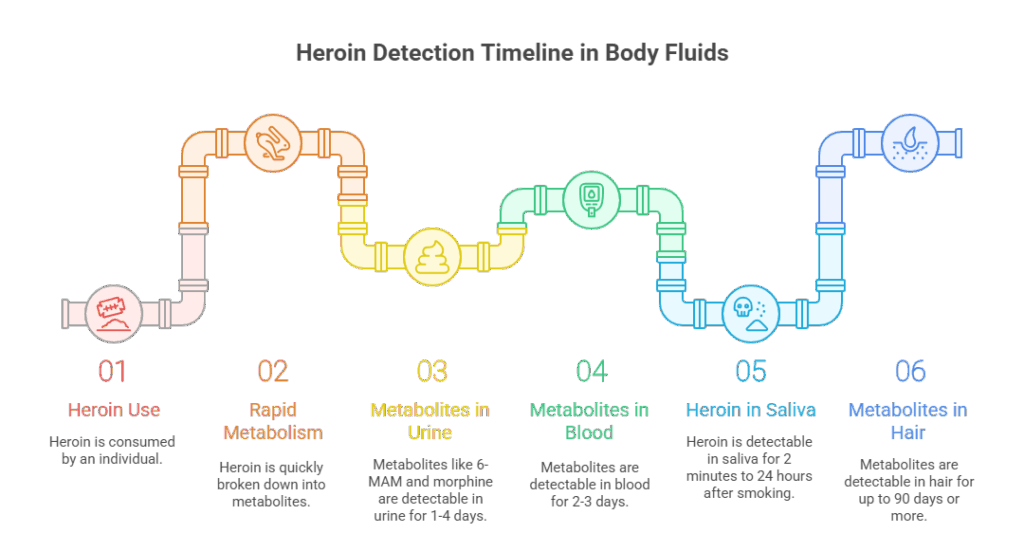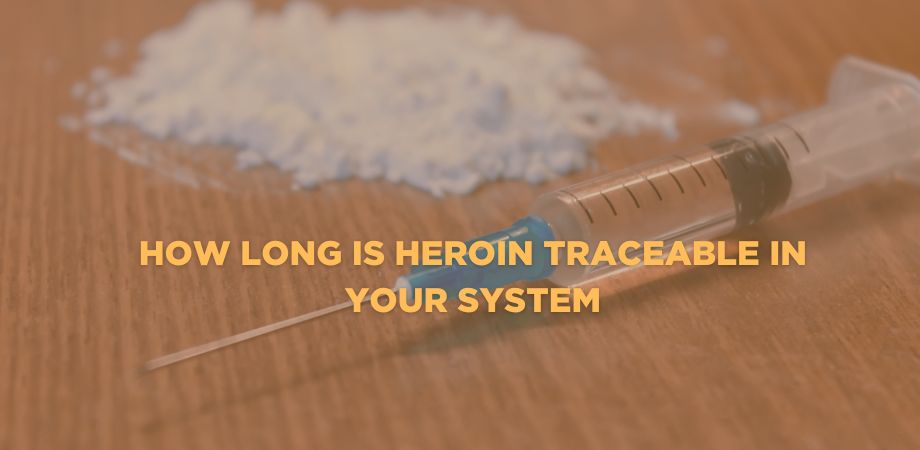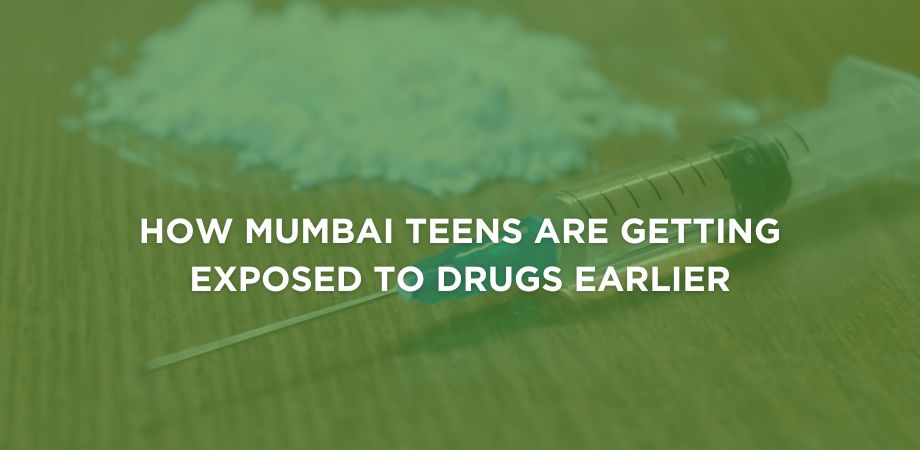Heroin stays in your system for about 1 to 4 days, depending on the type of drug test used and various individual factors. The duration heroin remains detectable varies with the testing method. Urine drug screen tests detect heroin for 2 to 3 days, blood tests for approximately 2 to 12 hours, saliva tests for 1 to 36 hours, and hair follicle tests can detect heroin use up to 90 days after consumption.
These differences arise because heroin is quickly metabolised in the body, and tests detect its metabolites rather than the drug itself. Factors such as frequency of use, metabolism speed, body fat, and health can influence these detection windows.
Approximately 1.14% of India’s population uses heroin. Opioid use overall is reported at 2.1% of the population, with heroin being the highest among opioids, followed by pharmaceutical opioids at 0.96% and opium at 0.52%, according to Singh, O. P. et al (2020) study titled, “Substance Use in India” published in the Indian Journal of Psychiatry.
The common withdrawal symptoms of heroin include muscle and bone pain, insomnia, diarrhoea, vomiting, cold flashes with goosebumps, and intense cravings for the drug. To get heroin out of your system, the primary step is to stop using it and allow the body to naturally metabolise and eliminate the drug, often supported by medical detoxification and treatment to manage withdrawal symptoms safely.
What Factors Impact How Long Heroine Stays in Your System?
The factors that impact how long heroin stays in your system include frequency and amount of use, metabolism rate, body fat percentage, age, liver and kidney health, hydration levels, and route of administration.
In regions severely affected by heroin addiction, like Punjab and Kashmir, heroin use contributes significantly to addiction problems, with high rates of intravenous drug use. Kashmir saw a dramatic increase in drug users from about 350,000 to 1.35 million within a year, with many using heroin, according to Sharma, B., et al (2017) research titled “Drug Abuse” published in the Journal of Family Medicine and Primary Care.
Below are the factors that impact how heroin stays in your system:
- Frequency and amount of heroin use: More frequent or heavier use leads to longer detection times as the drug accumulates in the body. This means that chronic users may test positive for heroin longer than occasional users.
- Metabolism rate: Faster metabolism breaks down heroin and its metabolites quickly. Individuals with a higher metabolic rate may clear heroin from their system faster.
- Body fat percentage: Heroin metabolites are stored in fat cells, extending detection time in individuals with higher body fat. Consequently, those with more body fat might retain traces of heroin longer than leaner individuals.
- Age: Older adults process heroin more slowly due to reduced metabolic and organ function. This slower processing can result in longer detection windows for older individuals.
- Liver and kidney health: These organs metabolise and excrete heroin, so their efficiency affects clearance time. Impaired liver or kidney function can cause heroin to remain in the body longer.
- Hydration levels: Proper hydration helps dilute urine, which may affect detection. Staying well-hydrated can sometimes lower the concentration of heroin metabolites in urine tests.
- Route of administration: Injecting, snorting, or smoking heroin can affect how quickly the drug is processed. Different routes influence absorption speed and the duration heroin remains detectable.
How Long Does Heroine Stay in Urine?

Heroin stays in urine for about 1 to 4 days after last use. Heroin has a very short half-life (half-life of heroin: 2–6 minutes) and is metabolised rapidly, but its metabolites, such as 6-MAM (6-monoacetylmorphine) and morphine, remain detectable in the urine for this period.
The length of time heroin and its metabolites are detectable depends on factors such as the amount used, frequency and duration of use, the user’s metabolism, age, body composition, hydration levels, and overall health. The reason for this duration is that heroin is quickly metabolised into other substances that stay longer in the body.
How Long Does Heroine Stay in Blood?
Heroin stays in the blood for 2 to 3 days after use. This duration allows for testing to identify heroin metabolites, primarily morphine and 6-MAM (6-monoacetylmorphine), which remain in the urine after the heroin itself is metabolised. The kidneys filter these metabolites into urine, making urine testing a common and effective method for detecting recent heroin use due to its non-invasive nature and relatively long detection window.
How Long Does Heroine Stay in Saliva?
Heroin stays in the saliva between 2 minutes after use and up to 24 hours after smoking it. It remains in the saliva between 2 minutes after use and 24 hours after smoking it. This detection window is most effective for heroin that is smoked, and detection times may vary for other forms of heroin use. Saliva tests have a shorter detection window than urine or hair follicle tests, but can be more accurate if applied within this timeframe.
How Long Does Heroine Stay in Hair?
Heroin stays in the hair for up to 90 days or more after consumption. Heroin metabolites enter the hair follicles from the bloodstream and remain trapped as hair grows. This method reflects long-term drug use rather than recent intake and is commonly used for historical drug use verification spanning several months.
What are the Common Withdrawal Symptoms of Heroin?
The common withdrawal symptoms of heroin are anxiety, muscle aches, sweating, nausea, vomiting, diarrhoea, insomnia, and intense drug cravings. These symptoms reflect the body’s physical dependence and discomfort from lack of the drug and can vary in severity depending on use patterns and individual health.
The common withdrawal symptoms of heroin are listed below.
- Anxiety: Anxiety refers to a feeling of worry, nervousness, or unease. During heroin withdrawal, anxiety occurs because the brain no longer receives heroin’s calming effects, leading to heightened nervousness and restlessness.
- Muscle aches: Muscle aches refer to pain or soreness in the muscles. Withdrawal causes physical discomfort as the body adjusts, often resulting in widespread muscle pain.
- Sweating: Sweating is the excessive production of sweat. The body activates its stress response during withdrawal, causing overactive sweat glands and excessive perspiration.
- Nausea: Nausea is the sensation of feeling sick to the stomach, often leading to the urge to vomit. Withdrawal disrupts the digestive system, causing queasiness and discomfort.
- Vomiting: Vomiting is the forceful expulsion of stomach contents through the mouth. This symptom is a result of digestive upset and irritation during withdrawal.
- Diarrhoea: Diarrhoea occurs through frequent, loose, or watery bowel movements.
The gastrointestinal system speeds up during withdrawal, causing diarrhoea and dehydration risks. - Insomnia: Insomnia refers to difficulty falling asleep or staying asleep. Without heroin’s sedative effect, the body struggles to relax, making restful sleep hard to achieve.
- Intensive drug cravings: Intense drug cravings refer to powerful urges to use heroin again.
These cravings result from the brain’s dependence on heroin’s chemical effects and the desire to relieve withdrawal discomfort.
Each symptom reflects how the body and brain react to the absence of heroin after dependence develops.
How to Get Heroine Out of Your System?
To get heroin out of your system, the most effective methods include detoxification, hydration, a healthy diet, exercise, medications, and de-addiction treatments.
Below are ways of getting heroin out of your system.
- Detoxification: Medical detox helps safely clear heroin from the body through supervised withdrawal. It also reduces the risk of severe withdrawal symptoms and complications during the initial phase of quitting.
- Hydration: Drinking plenty of fluids helps support kidney function and the elimination of metabolites. Staying hydrated helps flush toxins more efficiently through urine.
- Healthy diet: Proper nutrition supports liver health and metabolic processes. Nutrient-rich foods can boost the body’s natural ability to repair and detoxify.
- Exercise: Increases metabolism and helps burn fat cells storing heroin metabolites. Regular physical activity also improves circulation, aiding toxin removal from the body.
- Medications: Certain drugs, like methadone or buprenorphine, can assist detox and reduce withdrawal symptoms. These medications help manage cravings and make the detox process more tolerable.
- Professional de-addiction treatment: Comprehensive programs provide medical, psychological, and social support for sustained heroin clearance and recovery. They include counselling, therapy, and relapse prevention strategies for long-term success. You can get these services from a rehab.
Effective detoxification plays a crucial role in not only removing heroin from the body but also ensuring lasting healing and sobriety.
What Is Heroine?
Heroin (also known as diacetylmorphine) is an illegal opioid drug derived from morphine, which is extracted from the opium poppy plant. It produces intense euphoria and pain relief, but is highly addictive and has severe physical and psychological effects. Due to its rapid onset and potency, heroin poses a high risk of overdose and dependency.
How Long Does it Take to Get Addicted to Heroine?
To get addicted to heroin, it takes even using it once or a few times. The drug acts quickly on the brain’s reward system, creating strong euphoric effects that can lead to physical dependence and compulsive use in a short time frame, especially with repeated exposure.
How Long Does it Take to Get Addicted to Marijuana?
It takes about weeks or months to get addicted to marijuana. Marijuana addiction can develop over time, especially with heavy, regular use. The timeline varies by individual, but addiction risk increases with frequent use.
How to treat Heroine addiction?
To treat heroin addiction, a combination of medically supervised detoxification, medication-assisted treatment (using methadone, buprenorphine, or naltrexone), counselling, behavioural therapies, and long-term support through de-addiction centres is effective.
India-specific de-addiction centres or rehabs emphasise holistic care addressing medical, psychological, and social aspects of recovery to prevent relapse and promote sustained sobriety. Consider comparing an inpatient vs an outpatient rehab, in case you need to move in this direction.





